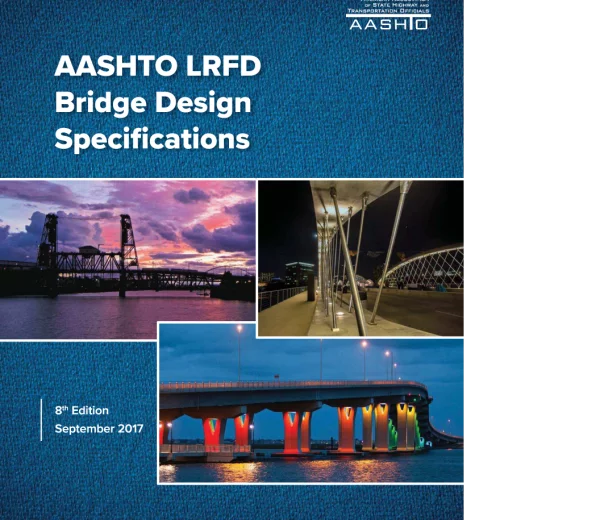-
资源简介
The AASHTO LRFD Bridge Design Specifications, 8th Edition, published in 2017, is a critical document for the design and construction of highway bridges in the United States. Developed by the American Association of State Highway and Transportation Officials (AASHTO), this specification provides a comprehensive set of guidelines and standards that ensure the safety, durability, and efficiency of bridge structures. The 8th edition represents an update to previous versions, incorporating the latest research, technological advancements, and lessons learned from past bridge failures and performance data.
One of the primary objectives of the AASHTO LRFD specifications is to implement a Load and Resistance Factor Design (LRFD) approach. This method differs from traditional Allowable Stress Design (ASD) by using probabilistic analysis to determine appropriate factors that account for uncertainties in material properties, load effects, and structural behavior. By applying these factors, engineers can design bridges that are both safe and economical, ensuring that they meet the required performance criteria under various loading conditions.
The 8th edition includes detailed provisions for the design of different types of bridges, including steel, concrete, and composite structures. It covers essential aspects such as dead and live loads, wind and seismic forces, temperature effects, and other environmental influences. Each chapter is structured to provide clear guidance on the application of LRFD principles, making it easier for engineers to follow the design process systematically.
A significant feature of the 8th edition is the inclusion of updated design equations and resistance factors. These updates reflect the latest findings from research studies and field observations, ensuring that the specifications remain current and relevant. For example, improvements in material science and structural analysis have led to more accurate predictions of structural behavior, which are now incorporated into the design methodologies outlined in the specification.
In addition to technical content, the AASHTO LRFD Bridge Design Specifications also emphasize the importance of quality assurance and quality control in bridge construction. The document outlines procedures for material testing, inspection, and documentation, ensuring that all components of a bridge meet the required standards. This focus on quality helps prevent potential defects and ensures that bridges are built to last for decades with minimal maintenance.
The 8th edition also addresses the growing need for sustainability and resilience in infrastructure. With increasing concerns about climate change and extreme weather events, the specifications include guidelines for designing bridges that can withstand higher loads and more severe environmental conditions. This forward-looking approach ensures that future bridges will be better equipped to handle the challenges posed by changing climatic conditions.
Another important aspect of the AASHTO LRFD Bridge Design Specifications is its role in standardizing bridge design practices across state transportation departments. By providing a common set of design criteria, the specification promotes consistency and efficiency in bridge planning and construction. This standardization not only enhances the safety of bridges but also facilitates collaboration among engineers, contractors, and regulatory agencies.
The 8th edition also includes updated references to other AASHTO documents and external standards, such as those from the Federal Highway Administration (FHWA) and the American Society of Civil Engineers (ASCE). These references help engineers access additional resources and ensure that their designs comply with broader industry standards and regulations.
Overall, the AASHTO LRFD Bridge Design Specifications, 8th Edition, 2017, serves as a vital tool for civil engineers involved in bridge design and construction. Its comprehensive coverage, updated technical content, and emphasis on safety and quality make it an essential reference for professionals in the field. As the transportation infrastructure continues to evolve, this specification will play a crucial role in shaping the future of bridge engineering in the United States.
-
封面预览

-
下载说明
预览图若存在模糊、缺失、乱码、空白等现象,仅为图片呈现问题,不影响文档的下载及阅读体验。
当文档总页数显著少于常规篇幅时,建议审慎下载。
资源简介仅为单方陈述,其信息维度可能存在局限,供参考时需结合实际情况综合研判。
如遇下载中断、文件损坏或链接失效,可提交错误报告,客服将予以及时处理。